
Native Plants
Featuring American Beauties Native Plants
Acorus americanussweetflag
Acorus americanus is a hardy perennial swamp or bog plant with sweet, spicy-scented leaves. Spadix-like flowers appear in June and July, followed by dark berries. Found at water's edge from Nova Scotia to Virginia to Washington to Alaska. Great for stabilizing pond edges or filling a boggy area. [
More Info
]
|
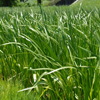
|
Adiantum pedatumnorthern maidenhair
Dainty, bright green fronds are held aloft on shiny black stems, creating a light, airy texture in the woodland garden. In rich soil and bright shade it will spread by shallow rhizomes to form a dense groundcover. Found in the humus-rich woodlands and moist woods of Eastern North America. Easy to grow as long as the soil is loose and rich. [
More Info
]
|
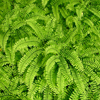
|
Agastache foeniculumanise hyssop
An upright, clump-forming perennial native to parts of the upper Midwest and Great Plains region. Lavender to purple flowers are densely packed along showy, cylindrical, terminal spikes mid to late summer. Medium green, lanceolate foliage remains clean throughout the season and carries a refreshing anise scent, attracting hummingbirds and butterflies. [
More Info
]
|
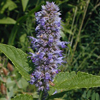
|
Allium cernuumnodding onion
Found on ledges, in dry meadows, gravel, rocky or wooded slopes, this delicate onion has gently nodding pink flowers in late spring. Beautiful in the garden or naturalized in a meadow. Easy, dependable and very drought tolerant once established.
[
More Info
]
|
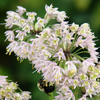
|
Amsonia hubrichtiithreadleaf bluestar
A graceful and long-lived native plant with very fine foliage, clusters of steel blue flowers in May and June on an upright, bushy plant. Excellent golden fall color. Thrives in full sun or part shade. No insect or pest problems. Found in Arkansas in 1942 by Leslie Hubricht. [
More Info
]
|
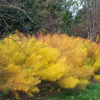
|
Andropogon gerardiibig bluestem
The king of native grasses, big bluestem has handsome gray to blue-green stems in spring, turning to green alternating with deep red in summer, then to coppery red in fall. Three-fingered seed heads top tall stems in August. Clump forming with excellent drought tolerance once established. Found naturally in moist meadows and along side roads and rivers from Canada to Mexico. [
More Info
]
|
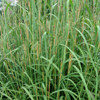
|
Andropogon virginicusbroomsedge
An easy-to-grow, clump-forming, native warm season grass with incredible golden copper fall color. A pioneer soil stabilizing plant that does well in poor, infertile areas and surprisingly well in floodplains. It's wonderful for xeriscaping and restoration projects, or in coastal areas. The attractive fall and winter stems make a unique addition to cut flower arrangements! [
More Info
]
|
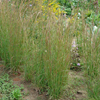
|
Anemone canadensisCanadian anemone
A strong-growing plant that needs room to move. Clear white single flowers top out at 18" from mid spring to early summer. A robust and competitive native plant that brightens up woodland edges and shady corners of the garden. Combines well with other spring-blooming perennials such as Polemonium, Sisyrinchium and Mertensia. [
More Info
]
|
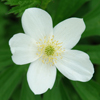
|
Antennaria plantaginifoliapussytoes
Looking for a tough groundcover that thrives in full sun, dry, and lean soils? Need it to be low-growing with an attractive but discrete foliage? Then, look no further. Antennaria plantaginifolia fills that niche with style. Native to the eastern United States, this little plant is great in an open woodland edge, rocky slope, rock gardens, or prairie. [
More Info
]
|
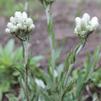
|
Aquilegia canadensiswild columbine
Red flowers with yellow centers hang like drifts of softly illuminated lanterns in April and May. Excellent as a shady rock garden naturalizer, it also is quite content in average garden conditions. Occurs naturally in rich rocky woods, north-facing slopes, cliffs, ledges, pastures, and roadside banks. Native to all states east of the Rockies, but not found in Louisiana. [
More Info
]
|
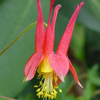
|
Aquilegia canadensis 'Little Lanterns'dwarf wild columbine
'Little Lanterns' is short in stature, but free with flowers! Numerous pendant flowers of red and yellow cover the plant in late spring. This selection resolves a few grievances that some have expressed about Aquilegia canadensis by having consistantly shorter stature and more intense color than the species. [
More Info
]
|
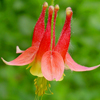
|
Aquilegia canadensis 'Corbett'wild columbine
Profuse show of butter-yellow, lantern-shaped flowers from April to May. Its short stature, delicate color and mid spring bloom time make it an ideal companion for spring bulbs! It was spotted by Lawrence Clemens who asked that it be named after the Corbett Historic District which is near Monkton in Baltimore County, Maryland. Bluemount Nurseries, of Monkton, MD was the first to offer this charming local Aquilegia to the market. [
More Info
]
|
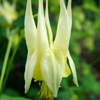
|
Aruncus dioicusgoat's beard, bride's feathers
A fantastic native with large, fine-textured feathery blooms in late Spring. Though closely related to Spiraea, goat's beard more closely resembles a giant Astilbe. When happy, Aruncus can be a formidable garden plant, reaching a spread of 6 feet or more. It is lovely when used at woods edge and it can provide a dense screen beneath a high canopy. [
More Info
]
|
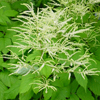
|
Asclepias incarnata 'Ice Ballet'swamp milkweed
A marvelous long-blooming, bright white selection of swamp milkweed. Clear white flowers and dark green foliage make the colors of the hundreds of visiting butterflies glisten in the sunlight.
[
More Info
]
|
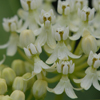
|
Asclepias incarnataswamp milkweed
One of the most beautiful of native perennials with clusters of upturned pink flowers in June and July. Much underused in average garden conditions! Attracts butterflies of all kinds. Willow-like leaves are 4-5" long. Occurs in floodplains and wet meadows. [
More Info
]
|
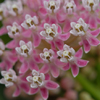
|
Asclepias incarnata 'Cinderella'swamp milkweed
She's the belle of the ball! Sweetly scented with blooms of blush pink, Asclepias incarnata 'Cinderella' from Walters Gardens lasts longer in your garden than her namesake. A perennial with beauty, grace, and staying power, this wetland native does well in average garden conditions and is a pollinator favorite! [
More Info
]
|
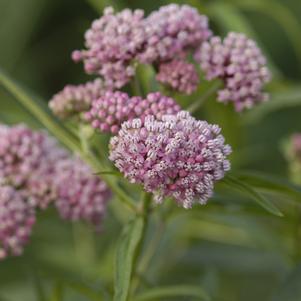
|
Asclepias syriacacommon milkweed
This native classic is best known as a food of larval monarch butterflies (along with its cousins A. incarnata and A. tuberosa). Robust, yet beautiful with deep pink clusters of fragrant flowers in June and July followed by lovely pods of silky seeds in October. [
More Info
]
|
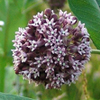
|
Asclepias tuberosabutterfly milkweed
A tough, drought-tolerant native with intense orange flowers in mid to late summer. Attracts many varieties of butterflies and is especially attractive to Monarchs. A beautiful solution for a dry sunny slope! Occurs in dry fields and roadsides in most of the US. [
More Info
]
|
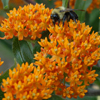
|
Asclepias verticillatahorsetail milkweed, whorled milkweed
A widely adaptable and tough native that is a deer-resistant food for larval butterflies. The fine-textured foliage provides a dark green backdrop for the clusters of white flowers that appear in June and July. [
More Info
]
|
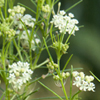
|
Aster cordifoliusblue wood aster
Clouds of blue flowers in early fall in shade! A great naturalizer under trees, at the edge of woods, or as a filler among Hostas and Astilbes, which look pretty rough by September. Found in woods and dry meadows. [
More Info
]
|
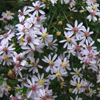
|
Aster cordifolius 'Avondale'blue wood aster
This selection of the native wood aster is a prolific bloomer, carpeting the shade garden with light blue in early fall, when little else blooms and the hostas are in decline. A quick and easy pot crop for fall sales. Beautiful and long-lasting as a filler in autumn flower arrangements! [
More Info
]
|
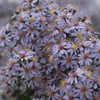
|
Aster divaricatus 'Eastern Star'white wood aster
We have grown this select form anonymously for many years and have deemed it worthy of a name. It is shorter than the species and has deep dark shining mahogany stems. It came our way from Canyon Creek Nursery, via Roger Rache, then of the Berkley Botanic Gardens's Eastern US section. Originally collected from coastal Rhode Island. [
More Info
]
|
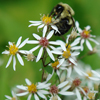
|
Aster divaricatuswhite wood aster
Produces a fairyland of glistening small white daisies in September and October. Lovely when naturalized in shade and average to dry soil. Found in deciduous woods and along roadsides of the Eastern US. [
More Info
]
|
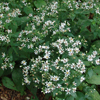
|
Aster ericoides 'Snow Flurry'white heath aster
A very low, dense carpeting groundcover that is smothered with 1/2" single white flowers with gold centers in September. A good strong grower and a totally new look and use for Asters! Makes an excellent container plant. [
More Info
]
|
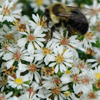
|
Aster laevis 'Bluebird'smooth aster
'Bluebird' is a superlative selection of the native smooth aster introduced by Dr. Richard Lighty of the Mt. Cuba Center. This tall, vase-shaped wildflower has large 1" diameter blue flowers held in cloud-like clusters at the tips of the arching branches. You can pinch back the young shoots in June for denser habit and more flowers, but it is not essential. Staking is helpful by late summer if you forget to pinch. Perfectly clean foliage makes for easy maintenance in production and in the landscape. Aster laevis is a great source of nectar for migrating monarchs and other late season butterflies. Ranked #1 in Mt. Cuba Center's aster evaluations. [
More Info
]
|
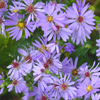
|
Aster lateriflorus 'Lady in Black'calico aster
Who can resist plants with great names? Aster 'Lady in Black' is an elegant 3-4' mound of purplish-black strappy leaves smothered in red-centered tiny white daisies in late summer and early fall. A stronger, more statuesque sister of Aster 'Prince' that will thrive in average soil in sun or part shade, but shows best foliage coloration in full sun. Thousands of flowers per plant—a butterfly's dream! [
More Info
]
|
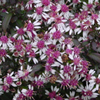
|
Aster novae-angliaeNew England aster
Blooms ranging from blue-purple to lavender-pink pop in the late summer and fall landscape. A large, showy native aster that is a must-have autumn nectar source for pollinators. [
More Info
]
|
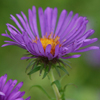
|
Aster novae-angliae 'Pink Crush' PP33628New England Aster
A dark pink fall-blooming aster with a tidy habit and smothered in flowers? Oh man, we think we may have developed a crush. A 'Pink Crush' that is. An introduction from Walters Gardens, this New England aster is a shorter variety that doesn't splay in the late season like other aster cultivars. [
More Info
]
|
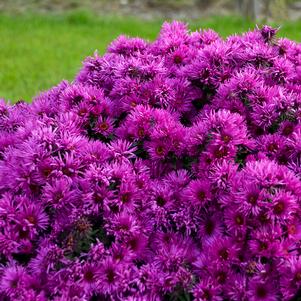
|
Aster novae-angliae 'Grape Crush' PP33612New England Aster
'Grape Crush' is a deep purple New England aster introduction by Walters Gardens. Growing into a neat mound 30" high by 40" wide, this fall blooming aster does not splay open as other aster cultivars can, providing a beautiful profusion of saturated flowers for a great fall display. [
More Info
]
|
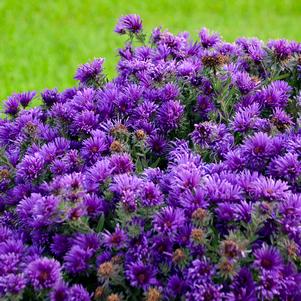
|
Aster novae-angliae 'Vibrant Dome' PP19538New England aster
Vibrant, hot-pink, star-shaped flowers with yellow center accents adorn lance-shaped green foliage through autumn. The compact, mounding habit of this sport of Aster 'Purple Dome' has proven mildew resistance. Reaching between 18 and 20 inches, 'Vibrant Dome' performs best in fertile, well-drained soil in full sun to part shade. A beautiful performer for late season color. [
More Info
]
|
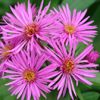
|
Aster novae-angliae 'Purple Dome'New England aster
A naturally compact form with deep purple flowers in August and September. Eye-popping with Solidago 'Golden Fleece'. One of the most garden-worthy native selections out there. A fine introduction from the Mt. Cuba Center. [
More Info
]
|
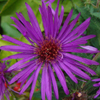
|
Aster novi-belgiiNew York aster
Local Mid-Atlantic native of moist to wet meadows. Flowers may vary in shades of pink, purple and white and bloom in early fall, which is late August and early September here in PA. [
More Info
]
|
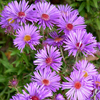
|
Aster oblongifolius 'October Skies'aromatic aster
Shorter, bushier, bluer sister of 'Raydon's Favorite'. A strong growing low mound of bushy foliage covered in lavender blue flowers in mid fall. Highly tolerant of drought and poor soils. This Primrose Path introduction has excellent groundcover potential.
[
More Info
]
|
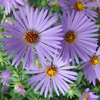
|
Aster oblongifolius 'Raydon's Favorite'aromatic aster
Medium blue, fine textured single ray flowers in September and October, aromatic foliage. Irresistable, a really tremendous plant. Introduced by Holbrook Farm. [
More Info
]
|
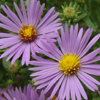
|
Athyrium filix-feminalady fern
Handsome crowns of feathery fronds are typical of this genus. Delicate and lacy with arching fronds and dark red stems at maturity. Strong-growing and dependable, lady ferns are great garden plants. Tough and easy to grow, this beauty is the right choice for perennial borders and woodlands alike. A breathtaking flush of new fronds appears in the spring, with new leaves appearing throughout the season for a continuously fresh look. Found in swamps, thickets and damp woods east of the Rockies. [
More Info
]
|
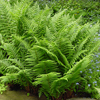
|
Athyrium filix-femina 'Victoriae'lady fern
"This is the most spectacular of all cultivars in its magnificent frond architecture. It is really the Queen of Green", according to Dr. John Mickel, former curator of ferns at the New York Botanical Garden and author of "Ferns for American Gardens". As with other forms of lady ferns there is so much variability with spore production that it is necessary to produce this form in tissue culture, so its clones are identical to the parent. This superb selection has fronds whose pinnae (leaflets) crisscross to form x's and has crested pinnae tips. Another superior cultivar in the Mickel Collection™. [
More Info
]
|
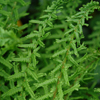
|
Baptisia alba var. macrophyllawhite false indigo
A tall and lovely prairie native with long spikes of pure white flowers from May to Mid-June. Easy and long-lived, it is native from New York to Minnesota, Texas to Mississippi. [
More Info
]
|
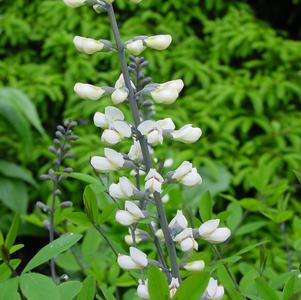
|
Baptisia australisblue false indigo
Blue spikes of pea-shaped flowers resemble the tall racemes of lupines in May and early June. A slow to mature, but very rewarding native garden perennial. Found in open woods, river banks and sandy floodplains, New York to Nebraska to Georgia.
[
More Info
]
|
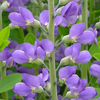
|
Baptisia sphaerocarpayellow wild indigo
A very sturdy, drought-resistant garden plant with striking spikes of pea flowers that range from butter yellow to gleaming gold.
[
More Info
]
|

|
Boltonia asteroidesfalse chamomile, false aster
Zillions of lacy white daisies top long stems of fine-textured silver blue foliage in late summer and early fall. An undemanding native plant that is surprisingly tolerant of drought and flood.
[
More Info
]
|
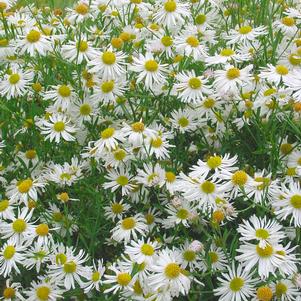
|
Bouteloua curtipendulasideoats grama
This drought-tolerant, warm season grass is often over-looked as a specimen; however, the unique flowers serve as a striking focal point in a small garden and mixes well in meadow plantings, as its stature compliments others well in the spring. [
More Info
]
|
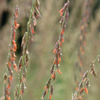
|
Callirhoe involucratawine cups, purple poppymallow
An outstanding and very attractive plant with low growing, deeply dissected dark green foliage that gives rise to an explosion of electric purple, single, upright flowers from July to early September. This plant behaves like an ivy. It is taprooted and can be difficult in containers if not well spaced. Let it drape over stone walls or creep between stones. Requires full sun and good drainage. Native to the Midwest.
[
More Info
]
|
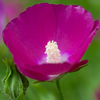
|
Caltha palustrismarsh marigold
Native to northern states and Canada, this little beauty is at home at pond's edge or along a stream. It is clumping by nature, but can seed in to form a dense groundcover in a consistently moist site. In early spring, hundreds of bright yellow buttercup flowers dot the green carpet of cordate foliage. Deer usually leave this alone! Found in marshes, swamps, and wet meadows from North Carolina to Alaska. [
More Info
]
|
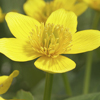
|
Carex amphibolacreek sedge
Carex amphibola is a widely adaptable native sedge naturally occurring from Texas to Quebec and Georgia to New Hampshire. Its forms a compact and semi-erect mound. Proven to be semi evergreen (zone 6b) and prefers deciduous shade in upland or even floodplain conditions; easily adapts to fine or medium textured soils. Creek sedge lends itself well to native shade gardens, along wood paths or as a slope stabilizer. It is a vigorous clump former with shiny, narrow green foliage 1/8" wide by up to 12" long. C. amphibola is an excellent companion for Phlox divaricata, Chrysogonum and Polygonatum...among others! [
More Info
]
|
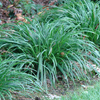
|
Carex appalachicaAppalachian sedge
This lovely sedge is native to the dry woods of eastern North America. Its fine texture and fountaining habit make it a lovely groundcover in dry shady sites, even in the root zone of trees. Its tidy clumping habit makes it a perfect feature in a container, rock or stump, or in a border planting along a walkway. [
More Info
]
|
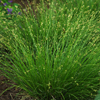
|
Carex cherokeensisCherokee sedge
Carex cherokeensis is a native sedge with a soft-medium texture. It prefers moist conditions but is adaptive. Grows in part shade but tolerates full sun in the morning. The inflorescence has been noted as insignificant but, we like the little wispy spikes that add a interest in the spring. [
More Info
]
|
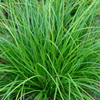
|
Carex eburneabristleleaf sedge
A wonderful naturalizer, Carex eburnea is the ideal native groundcover for the woodland or rock garden. Petite colonies of 6-8 inch long soft, thread-like foliage takes on a spherical shape as inconspicuous whitish-green flower spikes appear in early spring. [
More Info
]
|
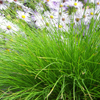
|
Carex flaccospermablue wood sedge
A beautiful native groundcover with striking glaucus blue foliage, Blue wood sedge is easy to grow and evergreen in warmer zones, though it benefits from a late winter cut back. Early spring flowers are slender and form interesting seed heads. Forms tidy clumps and spreads by seed. [
More Info
]
|
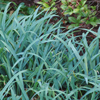
|
Carex laxiculmus Bunny Blue® 'HOBB'Bunny Blue sedge
Bunny Blue® is a low growing, evergreen, native sedge with silver-blue foliage. Use as a ground cover or specimen plant for moist to average shady areas. [
More Info
]
|
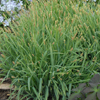
|
Carex muskingumensisMuskingum sedge
A fine-textured sedge that resembles palm fronds? How strange! Naturally occuring in moist habitats such as low, swampy woods and wet meadows, this native cool-season sedge adds textural interest to any planting. [
More Info
]
|
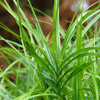
|
Carex pensylvanicaoak sedge
With its tough disposition and spreading habit, this native sedge makes an excellent shade groundcover. Fine texture and fountaining habit give this sedge a soft appearance that is lovely as an underplanting for bolder shade perennials or on its own as a shade lawn. Great in containers too! Easy to grow. Happiest in the company of oaks, but who isn't? [
More Info
]
|
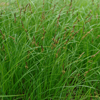
|
Carex plantagineaseersucker sedge
Shiny deep green leaves are unusually broad (to 1 1/8") and puckered like Christmas ribbon. An excellent, mostly evergreen (the basal foliage overwinters) groundcover for average to moist shade, provides unique texture. Flowers occur in early to mid-spring, thin and black-tipped, not especially showy. Found in moist woods from Canada to Alabama.
[
More Info
]
|
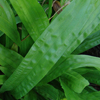
|
Carex radiataeastern star sedge
An attractive native sedge that forms dense tufts of foliage reaching 1–2' in height with an equal spread. Inflorescences range from 1-3" in length; blooming late spring. Very adaptable, dappled sunlight to medium shade, moist to mesic conditions, and a rich loamy soil with abundant organic matter. Incorporate with native ferns or spring ephemerals like Mertensia virginica. Seeds are enjoyed by various songbirds. [
More Info
]
|
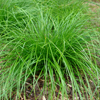
|
Carex rosearosy sedge
Carex rosea, or rosy sedge, is a petite woodland sedge with fine-textured foliage and elegant star-like flower clusters that appear in spring. Topping out at roughly a foot tall, the tidy bright green clumps provide form and function when used en masse—or is just as noticeable dotted about the landscape. [
More Info
]
|
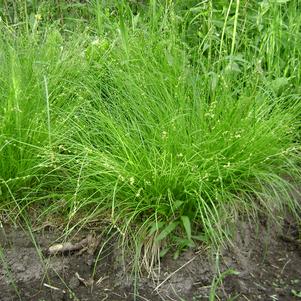
|
Carex strictatussock sedge
A wetland native that forms dense tussocks of straw-colored leaves at the base with bright green new growth emerging from the top. Spreads via rhizomes. Found in wet meadows. Emergent aquatic. [
More Info
]
|
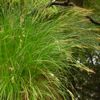
|
Carex vulpinoideafox sedge
One of the most widespread species of Carex in North America, growing in wet meadows, prairies, swamps and marshes. The seedheads mature in late summer and resemble fox tails, hence the common name. [
More Info
]
|
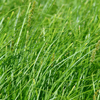
|
Chasmanthium latifoliumnorthern sea oats
A versatile native grass with bamboo-like foliage and delightful nodding seed heads that rustle in the breeze from late summer to winter. It grows in most sites and is a quite vigorous groundcover when given consistent moisture and sun. It is better behaved in average garden conditions and in shade. A unique cut flower in fresh or dry arrangements. [
More Info
]
|
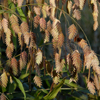
|
Chelone glabraturtlehead
Spikes of elegant white flowers top shiny green foliage in late summer and early fall. Grows best in moist meadows, stream banks, and swamps. Favorite breeding site for the Baltimore Checkerspot Butterfly. [
More Info
]
|
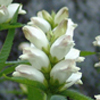
|
Chelone lyonii 'Hot Lips'turtlehead
Lustrous, deep green foliage is topped in August and September with rose pink, turtle-head-shaped flowers. Red stems persist most of the season. Bronze green early season growth is another distinctive feature. [
More Info
]
|
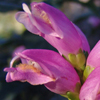
|
Chelone obliqua Tiny Tortuga™ 'Armitpp02' PP25350turtlehead
A tiny turtlehead with all the flower power of its taller brothers, this native cultivar features uniquely shaped, hot pink blooms atop lustrous dark green leaves with a bronzy sheen. Flowers reminiscent of turtles' mouths persist from mid-summer into fall, a favorite of butterflies but distasteful to deer. Its very compact habit is a great choice for mixed containers, or let it spread ever so slowly in the landscape along pond and stream edges, rain gardens or perennial borders. [
More Info
]
|
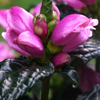
|
Chrysogonum virginianum 'Allen Bush'green and gold
A native groundcover, this plant is known for both its foliage and flowers with toothed, light green, triangular leaves and dark yellow, slightly notched, star shaped flowers that bloom well above the foliage and have contrasting brown stamens. The flowers bloom abundantly in the spring and fall, but tend to die down in the heat of the summer except in the cooler zones. [
More Info
]
|
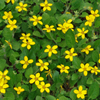
|
Chrysogonum virginianum 'Superstar'green and gold
This green and gold is sure to be a superstar on the retail bench and in the garden! Deep green, semi-evergreen foliage is topped with golden flowers in mid to late spring. It’s an easy native groundcover that blooms well and is a vigorous clump grower. [
More Info
]
|
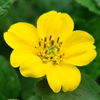
|
Chrysogonum virginianum var. australegreen and gold
One of our favorite native groundcovers for the woodland garden. Yellow daisy-like flowers cover 6" evergreen foliage in spring. Rosettes of leaves slowly spread stoloniferously. Looks great with columbine and Virginia bluebells. This golden star is very similar to Chrysogonum virginianum 'Allen Bush', but has shorter stems and stolons that spread above ground. With a compact and low growing form, this plant has deep, shiny green foliage and golden, star shaped flowers. [
More Info
]
|
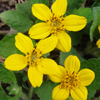
|
Clematis virginianaold man's beard
Blooming in late summer-early fall, this vigorous native Clematis virginiana is covered in showy, sweetly-scented white flowers that are 1" across. A fine addition to fences, on trellises, or trained up trees, Virgin's bower grows 12-20' tall. Commonly found in moist, woodland edge areas east of the Mississippi, it grows well in full sun but also can tolerate dry shade. [
More Info
]
|
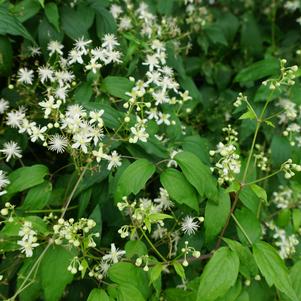
|
Coreopsis 'Crème Brûlée' PP16096tickseed
A more vigorous version of 'Moonbeam' that fills in faster in the spring and has larger flowers that occur all along the stems rather than just above the foliage, giving a fuller overall appearence. Overwinters well. [
More Info
]
|
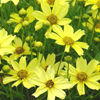
|
Coreopsis palustris 'Summer Sunshine'swamp tickseed
Vigorous mounds of foliage reach up to a sturdy 30” tall. Flower display lasts for a full 6 weeks. Bright and sunny for end of summer blooming that holds through the fall. C. palustris is native to the swampy forests of the south and particularly prolific in the Carolinas. It is one of the slower spreading Coreopsis and is a faculative that tolerates wet roots for extended periods. Mt. Cuba Center's 2015 Coreopsis Trial [
More Info
]
|
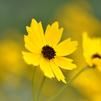
|
Coreopsis pubescens 'Sunshine Superman'star tickseed
A North Creek original, this selection of C. pubescens var. pubescens blooms non-stop from mid-summer until October here, with saucer-like flowers over low, spreading, slightly fuzzy foliage. An easy, self-sowing plant when happy. Likes hot, bright, well-drained spots, but is not fussy at all. An easy native for sun or part shade. [
More Info
]
|
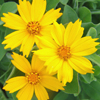
|
Coreopsis tripteris 'Gold Standard'tall tickseed
This accession of C. tripteris was collected by Mt. Cuba Center in the wild and shows better garden performance than the straight species. This plant is approximately 1’ shorter and blooms for an additional six weeks. The flowers were also born on shorter, secondary growth. This characteristic distributed the floral display throughout the entire plant rather than solely at the top. The cultivar name of 'Gold Standard' was assigned at the completion of the trial due to this selections superior performance compared to the straight species. Mt. Cuba Center Coreopsis Trial 2015 [
More Info
]
|
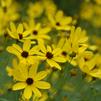
|
Coreopsis verticillata 'Moonbeam'whorled tickseed
Coreopsis 'Moonbeam' is a dependable bloomer and all-round fantastic plant. The flowers are a glowing, lemon-yellow color and sit on top of tall, erect, lacey, somewhat mound forming, delicate (threadleaf) looking green foliage that has an airy appearance. The flowers are plentiful and bloom continuously throughout the entire summer. If the dead blossoms are removed, flowers will be more abundant and healthy. Truly a bright sight. Great in rock gardens and gardens with poor soil. Makes a nice cut flower. [
More Info
]
|
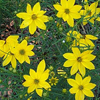
|
Coreopsis verticillata 'Zagreb'whorled tickseed
Winner of the 2001 RHS Award of Garden Merit, this threadleaf coreopsis is just a little bit shorter than 'Moonbeam'. 'Zagreb' has bright yellow flowers that sit atop tall, erect, lacey, somwhat mound forming, delicate (threadleaf) looking, green foliage that has an airy appearance. The flowers are abundant and bloom continuously throughout the entire summer. Removal of the dead blossoms encourages longer blooming and healthier flowers. Truly a colorful sight. Great in rock gardens and gardens with poor soil. Makes a good cut flower. [
More Info
]
|
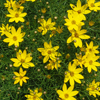
|
Coreopsis verticillatawhorled tickseed
This hardy species is a delightful and tough landscape solution. Taller and more vigorous than 'Moonbeam' or 'Zagreb', it has bright yellow flowers for 8 weeks or more, from late May to early August and often later. Drought tolerant and easy to grow in a garden or along the roadside. [
More Info
]
|
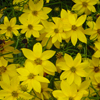
|
Deschampsia cespitosa 'Goldtau'tufted hairgrass
Selected for deep, dark-green foliage, late blooming period, clump-forming habit and airy, golden-yellow flowers that emerge in June and last through to September. Attractive seed heads persist through winter. An eye catching cool season, semi-evergreen ornamental grass perfectly suited for part sun to shade. [
More Info
]
|
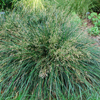
|
Deschampsia cespitosatufted hairgrass
An ornamental grass that does well in moderately shady locations. Airy masses of finely branched, light green inflorescences rise above the neatly rounded tufts of narrow, dark green foliage in early summer, and remain intact long enough to provide some early winter interest. [
More Info
]
|
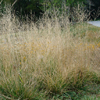
|
Deschampsia flexuosawavy hairgrass
A delightful and elegant native, this diminutive grass thrives in dry shade. Fine-textured and delicate in appearance, it is tough and drought tolerant, ideal for planting in any well-drained shady location as a groundcover. In spring it is topped with graceful feathery flowers that are lovely as they move quietly in the breeze. [
More Info
]
|
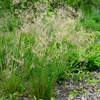
|
Dryopteris goldianaGoldie's woodfern
This is the largest of the native wood ferns, reaching 4' in ideal conditions. It is a stately and slowly spreading groundcover, forming large clusters of graceful arching fronds. Named for Scottish botanist John Goldie, its fronds are green without a hint of gold. Dryopteris goldiana is native to seepage slopes and moist woods from Newfoundland to Georgia, west to Minnesota and Arkansas. [
More Info
]
|
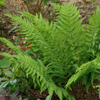
|
Dryopteris marginaliseastern woodfern
The leathery leaves of Dryopteris marginalis are a beautiful addition to the woodland garden and can form a lovely and easy to maintain groundcover. A sturdy east coast native, it forms a tidy clump that will not spread and is very tolerant of dry shade conditions once it has established. Marginal wood fern is often found in shaded crevices of rocky ledges and bluffs from Newfoundland to Georgia, west to Oklahoma and Minnesota. [
More Info
]
|
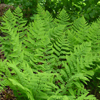
|
Dryopteris × australissouthern woodfern
Dryopteris x australis is a natural hybrid (D. celsa x ludoviciana) found in wild populations from Louisiana to Virginia, but is a superb garden plant as far north as Zone 5. It is taller than either parent and a formidable addition to the garden. [
More Info
]
|
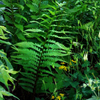
|
Echinacea paradoxayellow coneflower
A Yellow Purple Coneflower... thus the paradox. Relatively rare in the wild and in cultivation, this coneflower is stunning in summer. Its bright, pure yellow flowers consist of drooping petals surrounding a soft brown cone. Goldfinches devour the seeds. Native to the Ozark Mountains and surrounding areas. [
More Info
]
|
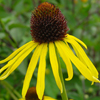
|
Echinacea purpurea PowWow® Whiteconeflower
Lend a classic look to your garden with Pow Wow® White’s graceful, downward arching and bright white ray petals surrounded by bright yellow cones. This spectacular variety is extremely well-branched for profuse blooms and summer to frost flower power! Amazing in a sunny perennial border or wildlife garden. Easy to grow and very adaptable to heat, humidity, drought and poor soils. [
More Info
]
|
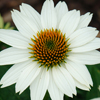
|
Echinacea purpurea 'Magnus'purple coneflower
Named by Klaus Jelitto of Jelitto Staudensamen (Perennial Seeds) in Germany, for Swedish nurseryman Magnus Nilsson, who carefully selected for ten years, looking for fine form, dark hue, and very horizontal petals. A tall, coarse plant with large, dark green leaves and a large, 3-4" flower with broad hot pink to purple petals that surround a brown/bronze cone. Plants are tough and heat and drought tolerant once established. Their roots have famous medicinal qualities, they make great, long lasting cut flowers and attract numerous butterflies and small birds. [
More Info
]
|
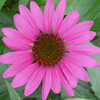
|
Echinacea purpurea 'White Swan'purple coneflower
'White Swan' is not as cold hardy or vigorous as its common purple relative, but it makes up for this with its unique, beautiful, pure white flowers. A tall plant with large, dark green leaves and a large, 3-4" flower with white, broad, silky petals that surround a dark brown/bronze cone. Plants are tough and heat and drought tolerant once established. Their roots have famous medicinal qualities, they make great, long lasting, cut flowers and attract numerous butterflies and small birds. [
More Info
]
|
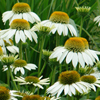
|
Echinacea purpurea 'Ruby Star'purple coneflower
Introduced by Jelitto, who gave us 'Magnus', Echinacea 'Ruby Star' is a slightly shorter plant with large flat topped flowers that are a deeper purple pink, almost ruby red, than most others. Plants are easy to grow, tough, and heat and drought tolerant once established. Their roots have famous medicinal qualities, they make great, long lasting, cut flowers and attract numerous butterflies and small birds. [
More Info
]
|
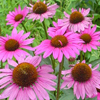
|
Echinacea purpureapurple coneflower
One of the great butterfly magnets of the native perennial garden! Coneflowers are easy to grow in average to dry, well drained soils. Flowers with large orange gold spiky centers and strong reflexed rose pink petals appear in July and August. Very drought tolerant. [
More Info
]
|
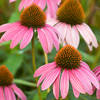
|
Echinacea purpurea PowWow® Wild Berryconeflower
Up the WOW factor in your garden with PowWow® Wild Berry, a 2010 All-America Selection award winner! This spectacular variety is extremely well-branched for profuse blooms and flower power summer to frost. Brilliant rose-purple flowers retain color longer without fading and will bloom without the need for deadheading. Amazing in a sunny perennial border or wildlife garden. Easy to grow and very adaptable to heat, humidity, drought or poor soils. [
More Info
]
|
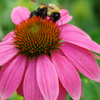
|
Echinacea purpurea 'Green Twister'coneflower
A release from Jelitto Perennial Seeds, Echinacea 'Green Twister' is a compact, sturdy plant with horizontal facing petals that change in color from edges of lemon green to a bright carmine red center. Colors vary by flower and give a pleasing range of color pattern. [
More Info
]
|

|
Echinacea purpurea 'Mellow Yellows'purple coneflower
A beautiful and long-lasting coneflower, Echinacea purpurea 'Mellow Yellows' is a seed introduction from Jelitto that ranges from light yellow to the deepest golden with bright orange centers. Flowering in its first season, this sturdy and reliable plant is an excellent cut flower and a great source of nectar and seed to pollinators and wildlife. [
More Info
]
|
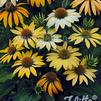
|
Eragrostis spectabilispurple lovegrass
Fluffy clouds of bronze-red inflorescences are soft and subtle in the sunlight. Light green foliage in summer turning to a bronzy-red in fall. Irresistible texture plant for the late summer garden. [
More Info
]
|
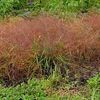
|
Erigeron pulchellus var. pulchellus 'Lynnhaven Carpet'Robin's plantain
We love this form of E. pulchellus which has large grey-green foliage and a mat-forming habit. It thrives in a wide range of conditions and forms a tight groundcover that is less than 6" tall. An easy to grow, carefree native perennial perfectly suited for moderate sunlight to full shade. [
More Info
]
|
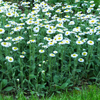
|
Eryngium yuccifoliumrattlesnake master
A unique and eye-catching plant for a dry, sunny site. Slightly spiny leaves are arranged in a rosette that resembles Yucca. Flower stems shoot skyward in summer and are topped with thistle-like bluish silver flowers. An architectural addition to the perennial border or meadow. Found in moist and dry sandy soils in open woods, fields, and prairies from Virginia to Minnesota, south to Texas and Florida. [
More Info
]
|
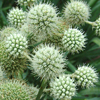
|
Eupatorium coelestinumhardy ageratum, blue mistflower
Fuzzy blue flowers atop attractive red stems, in September and October, make great cut flowers. This plant can be aggressive in Southern gardens. Found in old fields, meadows, and along stream banks. Naturalizes readily.
[
More Info
]
|
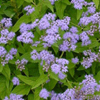
|
Eupatorium dubium 'Little Joe' PP16122Joe Pye weed
Selected by Steve Lighty while at The Conard-Pyle Co., this dimunitive Joe Pye has the vivid color of 'Gateway' at a height more appropriate for small gardens. 'Little Joe 'is also more compact in a container too.
[
More Info
]
|
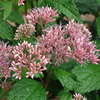
|
Eupatorium fistulosumJoe Pye weed
Joe Pye weed is a robust, upright perennial with hollow purple stems accented by huge, rounded, tight clusters of pink or purplish-mauve flowers. It is an important pollen and nectar plant and attracts butterflies (particularly the swallowtail butterfly) and other pollinators by the dozens. Its height makes it an excellent background plant in border perennial beds, but is also majestic standing alone. Flower color is darker in cooler weather. [
More Info
]
|
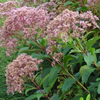
|
Eupatorium maculatumspotted Joe Pye weed
Spotted Joe Pye weed grows 4-7 feet tall with mauve-pink flowers blooming in late summer to early fall. A native perennial, Eupatorium maculatum attracts swallowtail butterflies and lives happily in sunny, wet soils. [
More Info
]
|
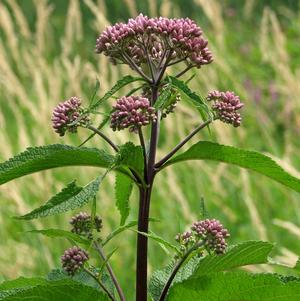
|
Eupatorium perfoliatumcommon boneset
Loose, white, flat-topped flowers over deep green foliage with hairy stems. E. perfoliatum is a clumping, slightly aromatic, easy to grow plant with low maintenance. Great for attracting butterflies. E. perfoliatum may be used in border and wildflower gardens, around the banks of a pond and in areas in which it may naturalize. [
More Info
]
|
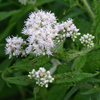
|
Eupatorium purpureum ssp. maculatum 'Gateway'Joe Pye weed
Like others in this genus, 'Gateway' is no exception in its power to attract butterflies with its huge, bright mauve-pink flower clusters atop deep wine red stems. July to September bloom makes 'Gateway' a bold and dramatic display when planted with Rudbeckia 'Autumn Sun' or tall ornamental grasses. Outrageous! [
More Info
]
|
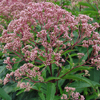
|
Gaura lindheimeri 'Siskiyou Pink'beeblossom
A Siskiyou Nursery introduction. Wine-red buds opening to rose pink flowers with white stamens. Shorter than other varieties with darker foliage. Occasional white flowers will appear, but they are few. The stems culminate in racemes of orchid-like flowers that open a few at a time giving the plant the added bonus of a long blooming period. [
More Info
]
|
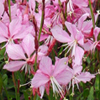
|
Gelsemium sempervirens 'Margarita'Carolina jessamine
A reliable zone 6 Gelsemium? This is it! It has flowered here in Landenberg for 10 years and the survival rate is 100%, with occasional dieback in the harshest winters. A profuse display of clear yellow trumpet flowers in early summer with semievergreen foliage. 'Margarita' is a superior seedling selected by Don Jacobs of Eco Gardens in Decatur, Georgia. With its much larger, more prominent flowers, it was superior in every way to common seedlings, so Jacobs named it for his wife. He had no idea that it would survive winters to minus 25 F as it has here in Pennsylvania. Gelsemium 'Margarita' is a Gold Medal Award winner from the Pennsylvania Horticultural Society. [
More Info
]
|
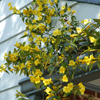
|
Geranium maculatum 'Espresso'cranesbill
We are very excited to offer our own selection from the woods of Landenberg! Pale lavender-pink flowers over very attractive maroon-purple foliage. A bold new look for our native cranesbill, useful as a groundcover or shade garden feature plant. G. maculatum is found naturally in open woods, clearings, woods edges and roadsides throughout the Eastern US. [
More Info
]
|
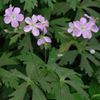
|
Geranium maculatumcranesbill
We are back on track with this great woodland native! Easy to grow in most shady spots, it flowers in spring with pink or lavender blooms. Found in open woods, clearings, woods edges and roadsides throughout the Eastern US. A necessary component for the shade meadow!
[
More Info
]
|
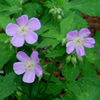
|
Helenium autumnalecommon sneezeweed
Our local native with yellow or bronze single daisy-like flowers on stout branched stems in late summer. Petals have distinct tooth-like indentations; hence the common name, dog-toothed daisy. All sneezeweeds have three-lobed petals which distiguish them from Rudbeckia and other yellow coneflowers. Brown, rust colored fruit appear in fall. Great for cut flowers and the avid butterfly gardener. [
More Info
]
|
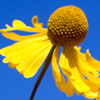
|
Helianthus 'Lemon Queen'sunflower
A free-flowering plant to brighten up the late summer garden. Covered in intense light yellow single 2-3" flowers from July to September. An irresistible butterfly plant. [
More Info
]
|
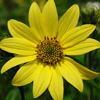
|
Helianthus salicifolius 'First Light' PP13150willowleaf sunflower
An explosion of golden yellow flowers combined with a manageable height makes this a superior selection. Despite its name, this plant can be found literally blanketed in flowers in the late summer and into the fall when most other Helianthus are past. Flowers form on upright, self-supporting stems but instead of the typical tall sunflower, Helianthus 'First Light' forms a nice, compact clump of fuzzy, linear leaves topping out just above 3 feet. [
More Info
]
|
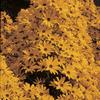
|
Helianthus salicifolius 'Autumn Gold' PP30117willowleaf sunflower
Blooming from September to a hard frost, Helianthus salicifolius 'Autumn Gold' is a wonderful addition to the perennial garden. The narrow, dark green willow-like leaves form into a tight mound giving a tidy shrub-like appearance from spring through summer before it erupts into color in the fall. [
More Info
]
|
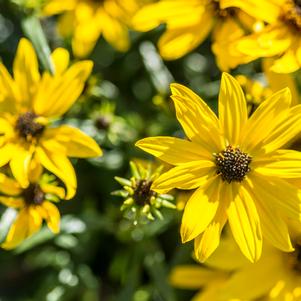
|
Heliopsis helianthoidessmooth oxeye
This local native sunflower happily naturalizes in moist or dry conditions. Upright and clump forming with bright, 2", single, medium gold flowers for eight weeks, peaking in July. Imagine, a self sowing butterfly magnet, that also doubles as a birdfeeder in the fall. Excellent cut flower! [
More Info
]
|
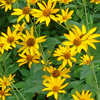
|
Heliopsis helianthoides var. scabra 'Burning Hearts'smooth oxeye
A seed selection by Jelitto Perennial Seeds, Heliopsis helianthoides 'Burning Hearts' stands 4' tall with dark red purple foliage and abundant contrasting yellow daisy-like flowers with orange centers. Plant begins blooming in its first year and blooms from June to mid-October. [
More Info
]
|
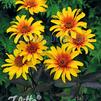
|
Heliopsis helianthoides var. scabra 'Bleeding Hearts'smooth oxeye
Another Heliopsis seed selection by Jelitto Perennial Seeds, Heliopsis helianthoides 'Bleeding Hearts' stands 4' tall with dark purple foliage and black stems providing a perfect foil for the blooms beginning at a fire red then orange-red turning to bronze colored as they fade. 'Bleeding Hearts' begins blooming in its first year and blooms from June to mid-October. [
More Info
]
|
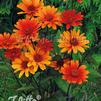
|
Heuchera 'Green Spice'alumroot, coral bells
Heuchera 'Green Spice' spices up the shade garden! With dark red venation in spring transitioning to cool greens and silver in the summer, it wraps up its foliage show with oranges and rust colors in fall! This groundcover is a perfect way to brighten up dull spots, to edge along a garden path, or to intermingle with other interesting textures to liven things up. [
More Info
]
|
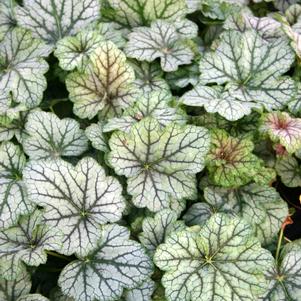
|
Heuchera americana 'Dale's Strain'American alumroot
This is a seed propagated strain selected by Dale Hendricks that is really fantastic and excitingly variable. Unique silver-blue marbled foliage accented by white flowers on long panicles in the spring. Excellent drought tolerant ground cover. Foliage display is amazing! [
More Info
]
|
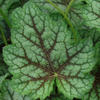
|
Heuchera longifloralongflower alumroot
A beautiful display when used en masse, the long flowering stems of this alumroot sway high above deep green foliage mottled in silver highlights. Tubular calyces surround the pale yellow flowers and securely affix them to upright stems. Expect flowering from late May into June. [
More Info
]
|
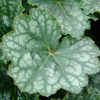
|
Heuchera macrorhiza 'Autumn Bride'alumroot, coral bells
Fuzzy, chartreuse to lime green, nearly evergreen foliage erupts in September with white fountains of pure white flowers continuing until frost. A very easy-care plant tolerant of dry shade and a wide variety of conditions. A good, tough exciting meat-and-potatoes groundcover that doubles as a cut flower! Great for moist shade. Named and introduced by Bluemount Nurseries, Monkton, MD. [
More Info
]
|
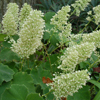
|
Heuchera micrantha 'Palace Purple'alumroot, coral bells
Deep purple, ivy-shaped foliage fades to bronze green in the heat of summer and becomes dark green in the fall. This plant has been an industry favorite for many years and was the Perennial Plant Association's Plant of the Year in 1991. [
More Info
]
|
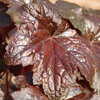
|
Heuchera villosa 'Bronze Wave'hairy alumroot, coral bells
A superb intro from Charles Oliver of the Primrose Path, this is a native late-flowering groundcover. This has much shinier, almost lacquered looking foliage vs. H. villosa 'Purpurea'. Like its cousin 'Autumn Bride', 'Bronze Wave' is sturdy, perhaps an 18", or a bit larger, clump. September-October flowering spikes of small tan flowers. Excellent shade groundcover that can happily compete with tree roots and come out looking good. [
More Info
]
|
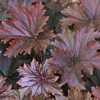
|
Heuchera villosa 'Caramel' PP16560hairy alumroot, giant alumroot
Bred by Thierry Delabroye, 'Caramel' has glowing apricot new growth fading to soft amber by summer. Fall color is an intense salmon red. Its lobed fuzzy foliage typical of H. villosa stays clean. An eastern US native species that is plenty hardy and unsurpassed for longevity, even in the prolonged heat and humidity of the south. Long panicles of creamy white flowers in late summer. [
More Info
]
|
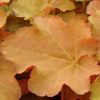
|
Hibiscus moscheutosswamp rosemallow
This shrublike herbaceous perennial is a vigorous grower with large, glabrous leaves and 4-5" wide flowers that range from pink to white. The flowers last only for one day, but they appear consistently until the end of the season. An amazing show of color and grace! [
More Info
]
|
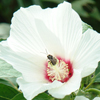
|
Iris cristata 'Powder Blue Giant'dwarf crested iris
Considerably more robust than the species, this sweet giant boasts 3" flowers of delicate light blue with golden crests and deep blue accents. Vigorous and easy to grow! [
More Info
]
|
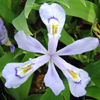
|
Iris cristatadwarf crested iris
Blue-violet flowers appear in early spring, carpeting the native woodland garden or shaded perennial border. Will naturalize, spreading to form a beautiful native groundcover. [
More Info
]
|
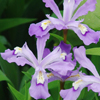
|
Iris cristata 'Tennessee White'dwarf crested iris
This delightful selection of our native crested iris came to us from Don Shadow in Winchester, TN. 'Tennessee White' is a vigorous spreader and prolific bloomer, covering the fan-like foliage with brilliant white flowers in spring, each accented with delicate yellow crests. Its late spring show starts earlier and lasts longer than the other selections we've tried. [
More Info
]
|
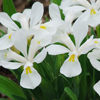
|
Iris versicolorblueflag
Very robust, dramatic display of boldly veined, swordlike leaves with large, violet-blue flowers accented by whitish markings at the base of the sepals. Petals and sepals spread out flat making it an attractive place for feeding by hummingbirds.
[
More Info
]
|
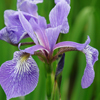
|
Iris versicolor 'Purple Flame'blueflag
Plainly stated, it’s a show stopper. Beyond other Iris selections on the market, ‘Purple Flame’ has a richer, more intense cast to stems and flowers, yes. However, the true beauty lies in the irresistible foliage. Emerging in March, the purple flame-like foliage provides an unparalleled performance of vivid and intense eggplant purple foliage followed by an encore of rich and abundant flowers. [
More Info
]
|
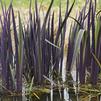
|
Juncus effusussoft rush
Juncus effusus is a clump forming wetland plant that is a striking vertical addition to any garden or container planting. Upright, fanning, deep green, rounded stems make a great accent in a container or water garden. Soft rush can be planted at the edge of a pond or in up to 6" of standing water. Inconspicuous golden flowers appear atop the stems in summer. Native to most of North America, soft rush provides food and shelter for birds and other wildlife. Distribution Map [
More Info
]
|
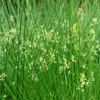
|
Juncus tenuispath rush
This durable native cool-season rush is deer-resistant and semi-evergreen. Perfect for everything from diminutive filler for rain gardens, as a groundcover, and for erosion control. [
More Info
]
|
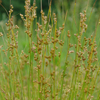
|
Liatris microcephalasmallhead blazing star
An exceptional, compact native with fine-textured, deep green grassy leaves. Smallhead blazing star sends up numerous spikes with tassel-like rosy purple flowers in August and September. Unique to the genus, the flowers open from top to bottom on the spike in a slow unfurling of brilliant color. Excellent as a cut flower. Tolerant of clay and drought, very low maintenance. Loved by butterflies! Liatris microcephala can be found in sandy, dry prairies and open glades of the Southern Appalachian Mountains. [
More Info
]
|
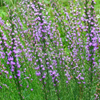
|
Liatris spicatablazing star
We are pleased to increase the availability of Pennsylvania provenance populations of our native gayfeathers. Tallest of the genus with upright spikes bearing pinkish-purple tassels in July and August. One of the best garden performers! An excellent cut flower and a magnet for butterflies, bees, rare moths and hummingbirds. Deer resistant! [
More Info
]
|
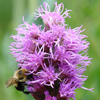
|
Lobelia cardinaliscardinal flower
Clump-forming habit with brilliant red flower spikes set against green and purple-bronze colored foliage. Each individual spike of scarlet flowers open from bottom to top and stays in bloom for several weeks. A favorite of hummingbirds. Makes an excellent cut flower. A real show stopper! [
More Info
]
|
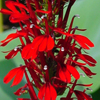
|
Lobelia cardinalis 'Black Truffle' PP25687cardinal flower
Wonderful in the perennial border and perfect for rain gardens, this cardinal flower is sure to stand out with its dramatic, dark chocolatey-purple foliage and bold red flowers. Superior to other dark-foliaged Lobelias on the market, 'Black Truffle' holds this deep color throughout the growing season. A magnet for hummingbirds and butterflies all summer, but deer tend to leave it alone. Introduced by Peter Heus and brought to market by Plants Nouveau. [
More Info
]
|
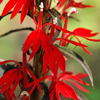
|
Lobelia siphiliticagreat blue lobelia
The spikes of brilliant true blue flowers on this wetland native attract butterflies, hummingbirds and neighbors to your garden! Lobelia siphilitica provides outstanding color for the border, wet meadow or pond edge. Naturalizes easily in moist soils, but tolerates periods of drought. [
More Info
]
|
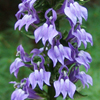
|
Lonicera sempervirenstrumpet honeysuckle
The sweetly-scented tubular red flowers of this native honeysuckle often attract hummingbirds to the garden throughout the summer. Flowers are followed by bright red fruit, attractive to birds. A twining vine, it needs a trellis or fence for support. [
More Info
]
|
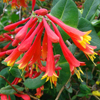
|
Lonicera sempervirens 'Magnifica'trumpet honeysuckle
The sweetly-scented tubular orange flowers of this native honeysuckle often attract hummingbirds to the garden throughout the summer. Flowers are followed by bright red fruit, attractive to birds. A twining vine, it needs a trellis or fence for support. [
More Info
]
|
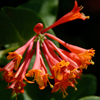
|
Lonicera sempervirens 'Major Wheeler'trumpet honeysuckle
Finally a production and landscape friendly native honeysuckle! 'Major Wheeler' is the best selection of Lonicera sempervirens we've grown and it stands out so far above the rest that we've dropped all other red cultivars. Clean foliage is the first benefit. Even in periods of drought or in overgrown production, we've never seen a speck of mildew on this one. But its real asset is FLOWER POWER! This selection is COVERED in red trumpet flowers in late spring and keeps churning them out all summer long, especially with a post-bloom trim. The hummingbirds will find it from miles around. [
More Info
]
|
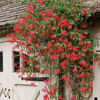
|
Lysimachia lanceolata 'Burgundy Mist'lance-leaved loosestrife
The short stature, continuous sunny bloom, and deep wine coloring of this native plant make Lysimachia lanceolata 'Burgundy Mist' a new favorite groundcover, winning over our Gardens Department by how it keeps weeds at bay and is a carefree plant. [
More Info
]
|
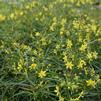
|
Matteuccia struthiopterisostrich fern
Large, lustrous, dark green fronds arch gracefully and give the tropical feel of a palm. Happiest in a cool moist site, it will tolerate more sun at the side of a stream or pond. Emerging fiddleheads are delectable sautéed in a bit of oil.
[
More Info
]
|
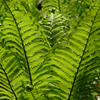
|
Meehania cordataMeehan's mint
Looking for a native substitute for Ajuga or Lamium? This could be it! Long, trailing stems run across the ground and root along the way. In late spring the green carpet gives way to hundreds of blue flowers opening to reveal spotted throats. Beautiful from a distance and under close scrutiny. Irresistible in a pot! [
More Info
]
|
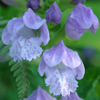
|
Mertensia virginicaVirginia bluebells
You know spring has arrived when the pendulous, trumpet-shaped flowers of Mertensia return. Flower buds start off pink and slowly transition to a soft blue as flowers develop. Foliage is smooth, oval, and has an attractive bluish cast. Beautiful when used en masse and left undisturbed. The perfect spring ephemeral for the woodland garden, incorporate with native ferns and sedges. Summer dormant. Best for planting directly into the landscape, as they must root in to return to bloom the following year. These ephemerals are not ideal for finishing in a pot for spring sales. [
More Info
]
|
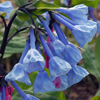
|
Monarda 'Purple Rooster'beebalm
The darkest, truest purple flowers to come out of Mt. Cuba’s bee balm evaluations—this selection has upright rigid stems, strongly verticality, and a rough, sand-papery texture to its foliage. Very resistant to powdery mildew. [
More Info
]
|
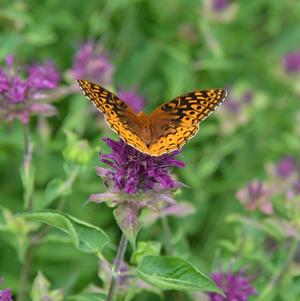
|
Monarda 'Judith's Fancy Fuchsia'beebalm
A fan favorite at Mt. Cuba Center’s Monarda trials thanks to superior resistance to powdery mildew—this selection boasts sturdy, upright stems, and a prolific floral display of purplish-red flowers atop clean green foliage. [
More Info
]
|
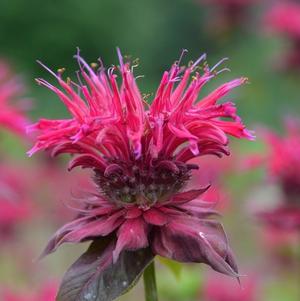
|
Monarda 'Gardenview Scarlet'beebalm
'Gardenview Scarlet' is one of the most mildew resistant Monarda varieties available. A classic variety that is well-earned, it's rose-red flowers sit on stems rising to 3' tall. Blooming from June to August, this long-flowering Monarda is beautiful, especially when massed in drifts to attract butterflies, bees, and hummingbirds. [
More Info
]
|
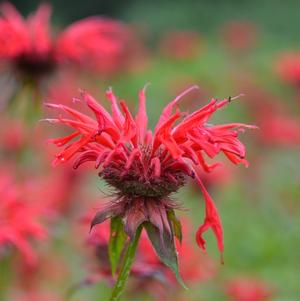
|
Monarda bradburianaeastern beebalm
Tubular, two-lipped, pink to light lavender flowers carry a purple tracking and bloom from spring into summer. A member of the mint family, this native bee balm is very attractive to pollinators and occurs naturally in open and dry, rocky woods from Alabama to Texas, north to Iowa. [
More Info
]
|
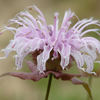
|
Monarda didyma 'Jacob Cline'beebalm
Named for the son of Georgia plantsman and garden designer Jean Cline. This is the ticket as far as mildew resistant Monardas. Wonderfully aromatic foliage and stems with enormous red tubular flowers from June to August. A Saul Nursery introduction. Cherished by butterflies and hummingbirds. Also makes an excellent cut flower! [
More Info
]
|
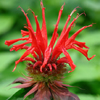
|
Monarda fistulosawild bergamot
Lovely lavender flowers top aromatic foliage. Easy to grow in a perennial border, wildflower garden or meadow. Wild bergamot is a great naturalizing wildflower and a magnet for butterflies and hummingbirds. Monarda fistulosa is more tolerant of drought and resistant to powdery mildew than M. didyma. [
More Info
]
|
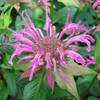
|
Monarda fistulosa 'Claire Grace'wild bergamot
This great plant was named by Mike and Barbara Bridges, of Southern Perennials and Herbs, for their daughter. Soft lavender pin cushion-like flowers. Quite mildew resistant, with excellent, shiny foliage. Extremely showy. A must for the avid butterfly gardener!
[
More Info
]
|
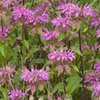
|
Monarda punctataspotted beebalm
A valuable ecological species, Monarda punctata is the equivalent of a juice bar at the gym for nectar loving/needing insects! BONUS, it also resists all other kinds of mites that could impact the bees because it is incredibly high in thymol. If you are in the area where the endangered Karner Blue still resides, you will be helping restore them to safe status by planting a stand of Monarda punctata, as this is their food mothership. [
More Info
]
|
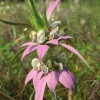
|
Muhlenbergia capillarishair-awn muhly
The very fine, blue foliage of Muhlenbergia capillaris provides color and texture to the garden, but in late summer or fall this native grass explodes into bloom with clouds of airy pink flowers that last for many weeks. Stunningly beautiful, even in heat, humidity or drought! [
More Info
]
|
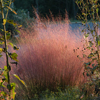
|
Muhlenbergia reverchonii UNDAUNTED® 'PUND01S'ruby muhly, seep muhly
Plant this muhlygrass for a show-stopping autumnal display! An aura of reddish mauve flower spikes bloom late summer into fall and will stop you in your tracks—a performance that intensifies when backlit by the rising or setting autumn sun. Striking when planted en masse, or lovely as an accent mixed into a perennial border. The clouds of flowers dry after frost and persist to provide winter interest. This warm season grass’s fine-textured, soft green foliage forms a tidy, well-behaved mound. Heat and drought tolerant, long-lived and low maintenance. [
More Info
]
|
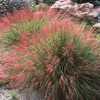
|
Oenothera fruticosasundrops
A tough and reliable perennial, well-suited to hot dry sites. The stems of Oenothera fruticosa are thin, hairy, and reddish with similar leaves. The buds begin as red but open into beautiful bright yellow flowers in early summer. Easy, dependable, a strong grower that can spread a bit, particularly in sandy soils. Great color for a meadow! Native to dry soil, open fields, and open woods from Nova Scotia to Florida. [
More Info
]
|
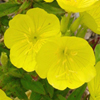
|
Oenothera fruticosa 'Fireworks'sundrops
Confused for many years in the trade, we are proud to carry the true 'Fireworks'. Deep bronze foliage and red stems are contrasted by red buds opening to canary yellow blooms in June. The individual flowers may not last for more than a day or two, but they open in succession leaving the plant in continuous bloom. Burgundy rosettes in winter. More compact and darker than 'Summer Solstice'. The most popular cultivar of the Oenotheras!
[
More Info
]
|
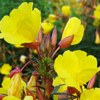
|
Oenothera speciosapink evening primrose
A vigorous, tough perennial that spreads readily to from dense mats of low-growing foliage. In late spring to summer, its covered with fragrant, pink to white blooms! Easy, dependable, a strong grower that can spread significantly, particularly in well-drained soils. Native to rocky prairies and plains, this plant spreads by seed and rhizome and is a great candidate for naturalizing an area. [
More Info
]
|
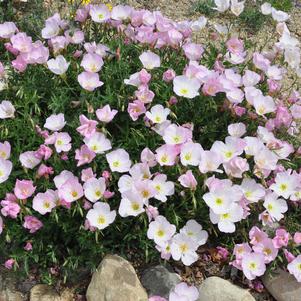
|
Onoclea sensibilissensitive fern
A freely running, deciduous fern with broad, deeply pinnatifid, smooth leaves. It spreads in moist soil and stays low to the ground, usually not more than 12-18", though heights of up to 3' are possible in ideal conditions. Very effective as a moist shade groundcover.
[
More Info
]
|
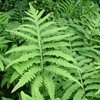
|
Osmunda cinnamomeacinnamon fern
Brilliant green lacy fronds gracefully arch outward in stately vase-shaped clumps. In early summer narrow fronds emerge as vertical spikes of cinnamon red brown in the center. Especially striking when planted in groups. Prefers a moist shady site, but tolerates more sun in cooler zones.
[
More Info
]
|
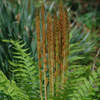
|
Osmunda regalis var. spectabilisroyal fern
Royal fern is truly one of the most distinctive and spectacular bold-textured deciduous native ferns with its light green, leathery leaves and graceful architectural stature. With adequate moisture, royal fern can reach 6' tall and create a lush, tropical feel along a stream or beside a pond.
[
More Info
]
|
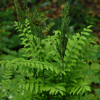
|
Pachysandra procumbensAllegheny spurge
Why plant English Ivy, Vinca or Liriope when you can enjoy this native evergreen gem? Fragrant, white flower spikes appear in spring, later becoming camouflaged by a new flush of gorgeous, crisp green foliage. Leaves have a scalloped margin and take on an attractive pale silver mottling. [
More Info
]
|
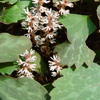
|
Packera aureagolden ragwort
Clusters of small golden daisy-like flowers appear over broad, shiny green, toothed basal leaves in May. Strong blooming, even in the shade. A robust groundcover where happy and an excellent cut flower. Self seeds and naturalizes. [
More Info
]
|
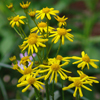
|
Packera obovataroundleaf ragwort
A tough groundcover, Packera obovata is similar to its popular cousin, Packera aurea, but with a smaller round leaf and the ability to withstand drier, full-sun conditions without losing its verdant appearance! [
More Info
]
|
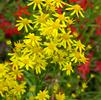
|
Panicum 'Cape Breeze' PP24895switchgrass
North Creek is proud to bring Panicum 'Cape Breeze' to the market. Fantastic foliage stays green until Halloween! From production to the landscape, this grass truly is a breeze. Selected for upright habit, compact size and early flowering. Its perfect, tidy stature combines the toughness of seaside Panicum with the neatness of garden worthy cultivars. Great texture and movement in the landscape! [
More Info
]
|
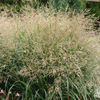
|
Panicum virgatumswitchgrass
An upright landscape grass with lovely blue green foliage that turns yellow in fall. In late summer airy wheat-colored flowers appear and remain attractive well into fall. It is an undemanding native grass suitable to any soil type. Tough and easy to grow!
[
More Info
]
|
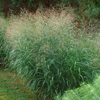
|
Penstemon 'Blackbeard' PPAFbeardtongue
Aaaarrrrgggghhhh! Named after the infamous English pirate Blackbeard, Penstemon 'Blackbeard' has the darkest of eggplant foliage with bright lilac-purple flowers rising high above and standing tall. With a long season of interest and a magnet for hummingbirds and bees, this Walters Gardens introduction is sure to cause a delightful cry of 'Shiver me timbers!' [
More Info
]
|
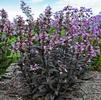
|
Penstemon digitalis 'Husker Red'beardtongue
This native makes a stunning display with its brilliant white flowers against a backdrop of deep red foliage. Tough and easy to grow, it tolerates a wide variety of conditions including hot, dry sites. Our plants are now vegetatively propagated from our reddest, most vigorous selections. [
More Info
]
|
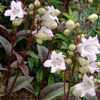
|
Penstemon digitalisbeardtongue
In early summer, white or light-pink-tinted, tubular 1" flowers on branching, hollow stalks rise above a basal rosette of lustrous dark green leaves. Drought tolerant, tough as nails, and deer resistant. The tubular flowers make an excellent landing pad for bees, butterflies and hummingbirds alike! [
More Info
]
|
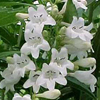
|
Phlox carolina ssp. carolina 'Kim'thickleaf phlox
Phlox carolina ssp. carolina ‘Kim’ is a fantastic selection that was discovered by Jan Midgley in Alabama. It performs much better than any other cultivar of Carolina phlox in our trial. What sets ‘Kim’ apart from other members of the species is its lush and vigorous habit (2’ tall) that remains sturdy and disease-free all season long. The leaves are also a lighter shade of green, almost lime-colored, which can prolong its horticultural interest in the garden. However, the most impressive feature of ‘Kim’ is its show-stopping light pink flowers which blanket the plant from late May through early June. - Mt. Cuba Center [
More Info
]
|
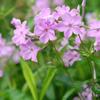
|
Phlox divaricata 'May Breeze'woodland phlox
A delightful spring-blooming native for shade, it carpets the shady border with nearly white blooms. 'May Breeze' will spread and fill in around bulbs or perennials that are late to emerge. A small-statured wild sweet william with loose clusters of fragrant, pale blue, almost white flowers that drive the butterflies wild! A Piet Oudolf introduction, from the Netherlands. [
More Info
]
|
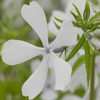
|
Phlox divaricata 'Blue Moon'woodland phlox
Selected for outstanding flower color and full petals, 'Blue Moon' bears many fragrant, 5-petaled flowers with the arrival of spring. Enjoy a knee-high sea of elegant, violet-blue flowers that attract hummingbirds & butterflies to your garden. Foliage is lance shaped and medium green. A long-lived, carefree native groundcover. [
More Info
]
|
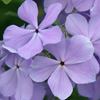
|
Phlox paniculata 'Jeana'garden phlox
Found by and named after Jeana Prewitt of Nashville, TN, this selection possesses outstanding mildew resistance with varying shades of sweetly scented, lavender-pink flowers, vibrant midsummer through early autumn. Foliage remains clean green while flower clusters create a tiered effect along upright, multi-stemmed branches. Expect a flurry of pollinator activity! [
More Info
]
|
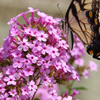
|
Phlox stolonifera 'Sherwood Purple'creeping phlox
Mat-forming habit with masses of star-like, clear purple flowers with deep green foliage. A beautifully vibrant groundcover that will bring excitement to the shade or woodland garden! [
More Info
]
|
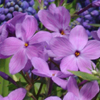
|
Phlox stolonifera 'Pink Ridge'creeping phlox
This stunning, bright pink flowering creeping phlox was one of the top performing pink cultivars in Mt. Cuba Center's Phlox trials. Sweetly fragrant flowers bloom in April. The dense, mat forming foliage is a lovely groundcover all season. [
More Info
]
|

|
Physostegia virginiana 'Pink Manners' PP23482obedient plant
Tubular flowers in shades of lavender-pink adorn this taller sport of 'Miss Manners' from midsummer through autumn. As expected, it holds an upright, clump forming habit with attractive medium green foliage and grows to about 36” tall and 20” wide. An adaptable and easy-to-grow native, the strong stems do not require staking. [
More Info
]
|
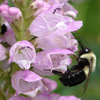
|
Physostegia virginiana 'Miss Manners'obedient plant
This plant was selected by Darrell Probst of Garden Visions in Hubbardston, MA. 'Miss Manners' is notable for its well-behaved, non spreading habit. It is a compact, clumping form, with excellent secondary branching and good rebloom. Pure white snapdragon-like flowers from June to September over deep green, glossy foliage. A nice late season addition to the garden for bees and hummingbirds. [
More Info
]
|
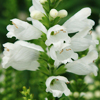
|
Polemonium reptans 'Stairway to Heaven' PP15187Greek valerian
This excellent variegated selection of P. reptans was selected by Bill Cullina of The New England Wild Flower Society. A good plant for shade or a sunny edge (with adequate moisture). Imagine, a variegated Polemonium that actually lives! This native groundcover is very popular, and its royalties benefit the Garden in the Woods and their plant and habitat conservation. [
More Info
]
|
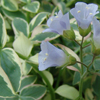
|
Polemonium reptansGreek valerian
A free-flowering woodland native with delicate light blue flowers topping ladder-like foliage in late spring. A good light-textured groundcover in areas with average to moist soils. [
More Info
]
|
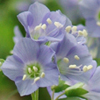
|
Polystichum acrostichoidesChristmas fern
While not as showy as some others, this fern makes up for it with its neat habit, easy culture, and its lustrous, nearly evergreen leaves. Often used in Christmas floral arrangements because it is still attractive in December. It is a wonderful companion for spring blooming bulbs. Found in acidic to neutral soils on shaded slopes and well drained flats. [
More Info
]
|
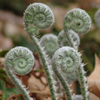
|
Porteranthus trifoliatusBowman's root
Bowman's Root is an easy-to-grow native for bright shade or partial sun and it tolerates tree root competition well as long at it has a nice layer of organic mulch. Bowman's Root is lovely in a mass planting where its lacy white flowers can shimmer in a light breeze. It makes a nice filler - think Gaura for shade! A compact, rounded plant is topped in late spring with ethereal white flowers growing in a few loose terminal panicles, with red petioles and mahogany stems. Clean, disease-free foliage often turns deep bronzy red in fall and contrasts beautifully with the more typical oranges and yellows in the perennial border. Interesting form and unique seed heads persist into winter. Great for cut flowers! [
More Info
]
|
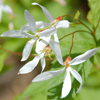
|
Porteranthus trifoliatus 'Pink Profusion'Bowman's root
We've been enjoying this great native for many years in our garden, since it was given to us by the Mt. Cuba Center in 2001. 'Pink Profusion' has clear pink flowers that are held daintily above reddish leaves on deep red stems. The best part is the way the flowers shimmer in a light breeze, as though they will take flight at any moment. [
More Info
]
|
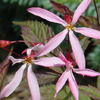
|
Pycnanthemum flexuosumAppalachian mountain mint
An aromatic, summer blooming, herbaceous perennial that produces silvery white, globular flowers on sturdy, upright stems. Blooming over a long period, flowers are prominently displayed above clean green foliage from summer into fall. A good soil stabilizer, this species spreads moderately via underground stem. Foliage develops an attractive red tinge in autumn. A larval host plant for the Gray Hairstreak Butterfly. Incorporate along the perennial border, rain garden, or near the vegetable garden to entice pollinators. [
More Info
]
|
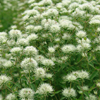
|
Pycnanthemum muticumclustered mountain mint
We give up! So many of you claimed this mountain mint to be superior to Pycnanthemum virginianum that we decided to try it for ourselves. We love it! Its leaves are broader and more lustrous, the bracts are silvery and very showy, the flowers are pinkish and its habit is more compact. Nicely aromatic. This native is happiest at the wood's edge, so it is excellent for a naturalized border or woodland garden. Mountain Mint is one of the best nectar sources for native butterflies, so butterfly gardeners can't do without this one. Our bees go crazy for it, too! [
More Info
]
|
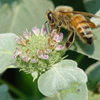
|
Pycnanthemum tenuifoliumnarrowleaf mountain mint
Densely branching with fine foliage and white flowers atop terminal clusters, Pycnanthemum tenuifolium, or slender mountain mint, has a more delicate appearance than P. muticum but with all the same pollinator action. Like its mountain mint brethren, P. tenuifolium spreads generously by rhizome making this plant a wonderful mass of white blooms in late summer. [
More Info
]
|
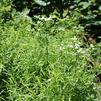
|
Pycnanthemum verticillatum var. pilosumhairy mountain mint
An attractive clump-forming native perennial with silver foliage. When the white flowers bloom in summer, they are covered in bees and butterflies! The seeds are loved by birds. This species makes a powerful addition to a pollinator habit hub! [
More Info
]
|
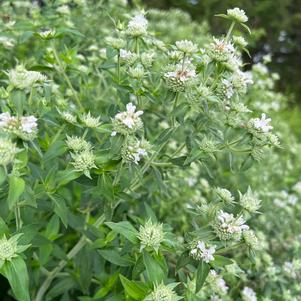
|
Ratibida columnifera 'Red Midget'upright prairie coneflower
Fun, unique flowers dance above mounds of fine green foliage from June until frost. The blooms feature long, prominent cones that give way to wide, reflexed petals in shades of deep reddish-brown, orange, and yellow. This plant is by seed, so there will be variation in the red/yellow ratio in the flowers. A native prairie plant, this dwarf variety of the species performs exceptionally well in hot and dry conditions. [
More Info
]
|
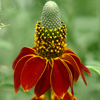
|
Ratibida pinnataprairie coneflower
Brown cones with reflexed yellow ray petals adorn this midwestern prairie native in midsummer. Emits a soft fragrance of anise when seeds are crushed. Long-lived and very easy to grow in most situations. Great for attracting birds and butterflies! Combines well with meadow grasses and flowers. Makes a wonderful cut flower, too! [
More Info
]
|
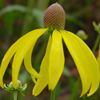
|
Rudbeckia 'American Gold Rush' PP28498orange coneflower
A new introduction from Brent Horvath of Intrinsic Perennials, this Rudbeckia is covered in blooms! A domed and shorter orange coneflower, it is perfect planted in masses or in the perennial border, hiding spent blooms to provide uniform color as it blooms for weeks on end. Due to its thinner, hairier leaves, it is found to be resistant to septoria leaf spot. [
More Info
]
|
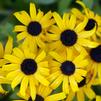
|
Rudbeckia fulgida 'Goldsturm'orange coneflower
A garden classic with bold texture and upright habit. Bright gold petals with a deep brown cone highlight the garden in late summer. Each flower may last up to two weeks! Makes a wonderful and long lasting cut flower. Provides seeds in the winter for birds and nectar for butterflies. Beautiful and versatile, outstanding in mass plantings as well as perennial borders, meadows and prairie gardens. [
More Info
]
|
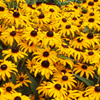
|
Rudbeckia fulgida var. deamiiDeam's coneflower
While there may be a bounty of black-eyed susan on the market, what makes Rudbeckia fulgida var. deamii a dream is its ability to wrap strength, beauty, disease and pest resistance all into one neat package. This variety won the prestigious Award of Garden Merit from the Royal Horticultural Society in 1993 and if you grow it, you'll soon understand why! [
More Info
]
|
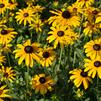
|
Rudbeckia fulgida var. fulgidaorange coneflower
Shiny, deep green foliage. Smaller and finer than Rudbeckia 'Goldsturm' with 10 weeks of flowers from July into October. Six weeks after 'Goldsturm' is brown, this plant is at its peak! Excellent cut flower. Provides late summer nectar for butterflies and seeds in the winter for birds. Beautiful and versatile! [
More Info
]
|
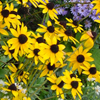
|
Rudbeckia fulgida var. sullivantii 'Little Goldstar' PP22397orange coneflower
This knee-high performer is a knockout in the landscape! Selected for copious floral display and dwarf habit with increased manageability, this variety has excellent branching and forms a tidy, compact clump. A bit more floriferous than 'Goldsturm', flowers are held high above rich green foliage and bloom from July into October. [
More Info
]
|
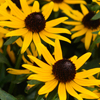
|
Rudbeckia laciniatacutleaf coneflower
This coneflower is a tall, erect and stately native with yellow ray petals accented by a green center held by coarse, hairy stems. Blooms in August and September. Excellent cut flower and butterfly magnet. R. laciniata can be found blooming in moist meadows, grassy roadsides and flood plains from Quebec to Montana south to Arizona and Florida. [
More Info
]
|
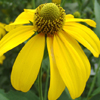
|
Rudbeckia laciniata 'Autumn Sun'cutleaf coneflower
This long-blooming butterfly (especially monarch) magnet has large, glossy, deep green, deeply cut leaves along the stems and loose clusters of clear yellow ray flowers with large green cones that darken with age. Blooms for 8+ weeks in mid to late summer. Very cold hardy. [
More Info
]
|
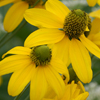
|
Rudbeckia maximagreat coneflower
Huge powder-blue leaves make up 2' to 3' of basal foliage that is effective all during the growing season. In June and July, towering flower spikes explode with large, deep gold, drooping ray flowers with a black center. A must-have for the butterfly and bird lover! Reliable and deer proof. [
More Info
]
|
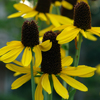
|
Rudbeckia subtomentosa 'Henry Eilers'sweet coneflower
Our friend Larry Lowman of Ridgecrest Nursery in Wynne, Arkansas graciously gave us this marvelous plant. It was collected from a railroad prairie remnant in southern Illinois and named for the man who found it, Henry Eilers, a horticulturist and retired nurseryman. Basal leaves appear in early spring and flowering stalks begin their ascent in June, reaching five to six feet and full flower by August, often staying in bloom into September. 'Henry Eilers' has finely quilled flowers of true yellow, not gold, and is stunning in a mass planting. It has captivated many visitors who have seen it here and motivated them to ask us to grow it. The leaves of Rudbeckia subtomentosa are sweetly scented with a subtle vanilla fragrance. It is lovely with Joe-Pyes and grasses, and it blooms with the Hibiscus hybrids and makes a great companion for them as well. 'Henry Eilers' has undeniable potential as a cut flower with its unique appearance, sturdy straight stems and long vase life. [
More Info
]
|
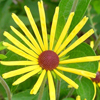
|
Rudbeckia trilobathree-lobed coneflower
Hundreds of small, deep gold flowers bloom July through October! A naturalizing self seeder. Biennial or short-lived perennial. Georgia Gold Medal Winner in 1997. Three-lobed coneflower is very drought, heat and pest tolerant. Prized by butterfly and hummingbird gardeners. [
More Info
]
|
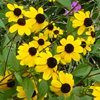
|
Rudbeckia triloba 'Prairie Glow'three-lobed coneflower
Rudbeckia triloba 'Prairie Glow' has our attention! With brightly colored flowers of yellow with a bright red eye fading to a glowing orange to bronze, this native beauty brings fire to the sunny border. Its multi-branching habit provides dense flower cover, more so than the straight species, and its late blooming time, starting in July and flowering right through to October, makes this a valuable pollinator plant. [
More Info
]
|
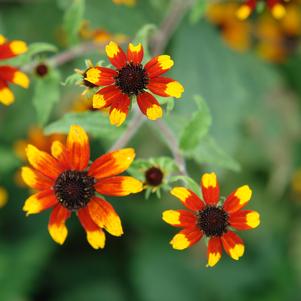
|
Ruellia humiliswild petunia
A drought-tolerant prairie native with delightful lavender-blue petunia-like flowers that bloom from summer to fall. Compact (great in pots!) and very easy to grow. Seeds in well. Great choice for a height-restricted meadow. Found in dry open woods and prairies Pennsylvania to Indiana, south to Alabama. [
More Info
]
|
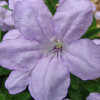
|
Salvia lyrata 'Purple Knockout'lyreleaf sage
Grown mainly for the foliage, 'Purple Knockout' has compact basal rosettes of shiny burgundy leaves that turn to deep purple in summer, then to red in the fall. Spikes of pale lilac-blue flowers appear in spring and summer, but sometimes the flowers have only calyces and no petals. We have not been able to determine the cause of this, but a cut back of the stems promotes new blooms that often have petals the second time around. Petals or no, the flowers are attractive to bees and butterflies. Very easy to grow in just about any soil, it will self sow to spread and become a dense groundcover that makes a great native substitute for Ajuga. [
More Info
]
|
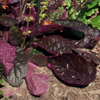
|
Schizachyrium littoralecoastal little bluestem
An underused but widely requested native warm-season grass, Schizachyrium littorale is a bushier version of the popular little bluestem, growing 2' tall. What makes it notable are the seedheads, which are featherier and stay on the stem well into the winter. We predict this dune bluestem to become a popular favorite in everything from dune restoration projects to coastal landscaping to low-maintenance high-exposure urban sites. [
More Info
]
|
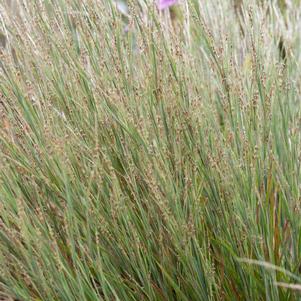
|
Schizachyrium scopariumlittle bluestem
An upright and clump forming native grass with spiky blades of blue and green. Wispy silvery flowers bloom in late summer, followed by a spectacular display of fall color changing from green and orange to deep burgundy. Remains attractive as an architectural feature through winter. [
More Info
]
|
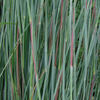
|
Schizachyrium scoparium 'Standing Ovation' PP25202little bluestem
A North Creek discovery sure to give a brilliant performance in the landscape, worthy of applause. It keeps a tight, upright habit throughout the entire season and has stood strong even in the rich soils of our trial gardens. A warm season grass that does well in poor, dry soils. Spikey bluish-green stems and leaves transition to a sizzling display of oranges, reds, yellows, and purplish-browns in the autumn. Also provides winter interest before cutting back in early spring to make way for new growth. [
More Info
]
|
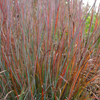
|
Scirpus cyperinuswool grass
A large, upright marsh grass with attractive wooly inflorescences that turn coppery in late summer and persist into winter.
[
More Info
]
|
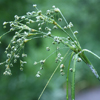
|
Scirpus validussoftstem bulrush
Obligate wetland plant for inland shallow waters, non-tidal marshes and wildlife. Large triangular dark green stems with brownish inflorescences hang pendulously from spring to fall. Stems are unusually spongy. Emergent aquatic. [
More Info
]
|
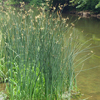
|
Scutellaria 'Appalachian Blues' PPAFskullcap
Scutellaria 'Appalachian Blues' is a cross of S. ovata and S. serrata, both plants indigenous to the mountains of West Virginia where breeder Peter Heus resides . The result of this cross? A compact habit, clumping skullcap with serrated leaves and dark margins that adapts to both sun and shade, with spikes of bicolor purple white flowers that bloom for weeks on end. [
More Info
]
|
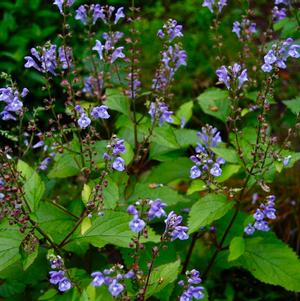
|
Scutellaria incanahoary skullcap
An eastern meadow native that provides weeks of color in mid-summer. Purple flowers top bushy green plants. Found at wood's edge and in sunny meadows from New York to Arkansas.
[
More Info
]
|
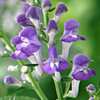
|
Sedum ternatum 'Larinem Park'stonecrop
A low-growing, succulent native groundcover for shade, it carpets the woodland floor with whimsical round leaves arranged in threes. In spring it is covered in white star-shaped flowers. A slowly spreading, floriferous selection from Mineral County, WV, via The Primrose Path of Scottdale, PA. 'Larinem Park' is more tolerant of shade and moisture than other Sedum species. [
More Info
]
|
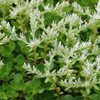
|
Silene caroliniana var. wherryi 'Short and Sweet'wild pinks
Delightful, compact and easy to grow, Silene 'Short and Sweet' is an excellent choice for bright shade or full sun. It is covered in deep pink flowers in late spring. Very reliable for us through wet and dry seasons, and in a cool spring it seems to bloom forever—one year we tracked 8 weeks of full bloom! A great native substitute for Dianthus, this Silene has similar appearance and bloom time, but tolerates a wider variety of garden situations. Silene 'Short and Sweet' is a fantastic plant for naturalizing, yet it can hold its own as a specimen in a container or patio garden as well. [
More Info
]
|
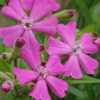
|
Sisyrinchium angustifolium 'Lucerne'blue-eyed grass
Bright blue star-shaped flowers with gold centers rise above fine, semi-evergreen, iris-like foliage from May to June. Excellent for edging, the 3/4" flowers are very good sized for the genus. We are very excited about this little gem. It will charm your customers for 8-10 weeks! Named by Robert Herman, who found it in Lucerne, Switzerland. [
More Info
]
|
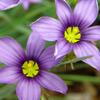
|
Sisyrinchium nashii 'Suwannee'blue-eyed grass
Soft blue star-shaped flowers with gold centers rise above fine, semievergreen, Iris-like foliage from May to June. Excellent for edging, the 3/4" flowers are very good sized for the genus. A strong floral show without seeding around and a tidier habit with more flower power than the straight species. [
More Info
]
|
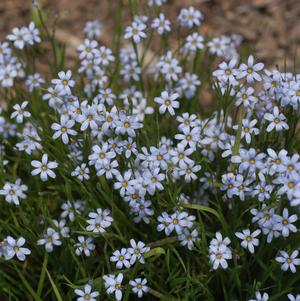
|
Solidago 'Solar Cascade'goldenrod
Delightful, golden-yellow flowers are borne in axillary clusters along reflexing stems from late summer into fall. Reliable, deep green, glossy foliage remains clean throughout the growing seasons. Not an aggressive runner, 'Solar Cascade' is a clump forming perennial reaching knee height, maxing out somewhere between the taller 'Fireworks' and more compact 'Golden Fleece'. Performs best in moist to average garden soil under full sun or partial shade; extremely drought tolerant once established. This great garden plant is easy to propagate and proved to be a standout in The Cincinnati Zoo and Botanical Garden perennial trials. Plant en masse for a dramatic effect or incorporate into seasonal arrangements. [
More Info
]
|
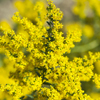
|
Solidago caesiabluestem goldenrod
This clump forming, non-invasive native perennial boldly displays arching wands of golden clusters in September, contrasted by blue-green stems. Adds life to a dry shady spot. Great with Aster cordifolius and Chasmanthium. Incredible butterfly magnet and cut flower! [
More Info
]
|
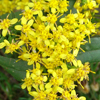
|
Solidago flexicauliszigzag goldenrod
Solidago flexicaulis brings pollinators to your dappled shade areas with a subtle yellow flower clusters in mid-summer to fall. A hardy native perennial, it tolerates deer, shade, and clay soils. [
More Info
]
|
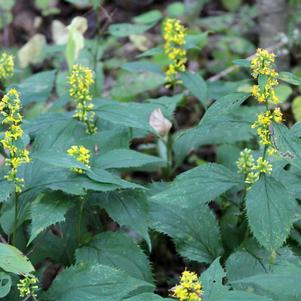
|
Solidago graminifoliaflat-top goldenrod
Fine-textured linear foliage and golden flat-topped inflorescences in late summer. Cherished by butterflies and preying mantises and well as the wildflower enthusiast. [
More Info
]
|
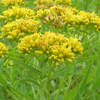
|
Solidago odoraanise scented goldenrod
Wonderfully fragrant leaves give off an anise scent when crushed, reminiscent of licorice candy! The lance-shaped leaves are a glossy, smooth dark green. S. odora has a tidy, clump-forming habit and is not weedy or aggressive in the garden. Attracts butterflies, bees, ladybugs, lacewings and other beneficial insects. Its high ecologial value and handsome appearance make it a valuable addition to wildflower gardens, meadows and naturalistic borders. [
More Info
]
|
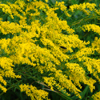
|
Solidago rugosa 'Fireworks'goldenrod
A compact, cascading, clump-forming native cultivar with a radiating flower form that really looks like fireworks! A great addition for late season color and to lure the butterflies in. Selected and named by Ken Moore of North Carolina Botanical Garden in 1970. Introduced by Niche Gardens. [
More Info
]
|
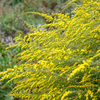
|
Solidago sempervirensseaside goldenrod
An east coast native that is useful for dune restoration projects, stormwater management, roadside, and habitat plantings. [
More Info
]
|
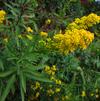
|
Solidago sphacelata 'Golden Fleece'autumn goldenrod
Another fantastic Mt. Cuba introduction. A stunning show of sprays of golden yellow flowers from mid-August through September. Semievergreen heart-shaped leaves. Truly an excellent groundcover and bee and butterfly charmer! Hairstreaks, sulphurs and skippers are particularly attracted to goldenrod. Monarchs visit it during their autumn migration. [
More Info
]
|
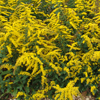
|
Sorghastrum nutansyellow prairie grass
A vigorous native warm season grass with bluish green foliage turning a translucent yellow-deep gold fall color and bearing beautiful panicles of copper. Excellent for cut flowers.
[
More Info
]
|
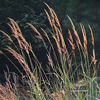
|
Sorghastrum nutans Golden Sunset® 'MNYG318153' PP33776yellow prairie grass
Brand new! We have had Golden Sunset® yellow prairie grass in our trials for a couple of years and couldn't believe how well it performed. Early flowering with gorgeous golden flower plumes, this Sorghastrum nutans selection from University of Minnesota produces hundreds of flowering stems to create a real show in the fall. It also has a very upright habit that does not lodge or fall over like the straight species tends to do. [
More Info
]
|
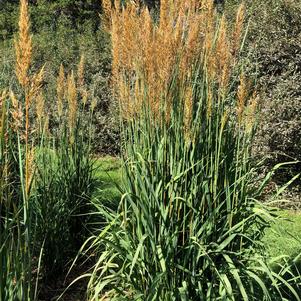
|
Sporobolus heterolepisprairie dropseed
According to wild Niel Dibol, of Prairie Nursery, Westfield, WI, it is "often considered to be the most handsome of the prairie grasses. It makes a well defined and very distinctive border." Fine textured, deep green foliage with lovely, light and airy flowers to 2 1/2" in September and October. Flowers have a slight fragrance similar to coriander. Often has glowing pumpkin orange fall color. Good drought tolerance. [
More Info
]
|
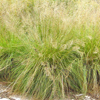
|
Stokesia laevis 'Peachie's Pick'Stoke's aster
'Peachie's Pick' isn't peach or apricot, but it is a fantastic plant for containers and for the garden! Selected in Peachie Saxon's Mississippi garden, this Stokesia has the typical lavender blue flowers of the species, but it is very compact and has incredible flower power. And the flowers just keep coming, especially with periodic trims. This is our new favorite! 'Peachie's Pick' combines well with pinks and pale yellows. [
More Info
]
|
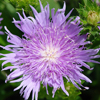
|
Stylophorum diphyllumcelandine poppy
Brilliant yellow flowers bloom in spring atop blue-green, pinnately lobed foliage. Leaf underside has a silvery cast. An easy-to-grow native that will self sow and form a dense shade groundcover. Tolerates all but the driest conditions. Beautiful paired with Mertensia virginica, Aquilegia canadensis, Aruncus dioicus, and Phlox divaricata. [
More Info
]
|
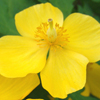
|
Thermopsis villosaCarolina Lupine
Clump-forming perennial with dense spikes of sulphur yellow in June resemble Baptista or lupines. Clean, compound foliage is attractive late into the season. Very durable and long lived once established. Beautiful cut flower. [
More Info
]
|
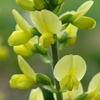
|
Tiarella cordifoliafoamflower
Foamflowers are commonly found in the woods of eastern North America, but not nearly often enough in gardens. They are easy to grow and many will spread when given moist soil high in organic matter and shade. In the early spring fairy wand flowers of white or light pink appear over green, deeply veined leaves which are often tinged with burgundy. [
More Info
]
|
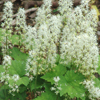
|
Tiarella cordifolia 'Brandywine'foamflower
From our friend Sinclair Adam (The Pharoah of Foamflowers) of Dunvegan Nursery, Tiarella cordifolia 'Brandywine' is rated as one of the most vigorous of the genus. A strong grower with glossy, rugose leaves and excellent bronze fall and winter color. Bold, creamy white flowers persist for 6 to 8 weeks. A robust clump former with some short runners in spring and fall. [
More Info
]
|
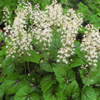
|
Tiarella cordifolia 'Running Tapestry'foamflower
A vigorous running groundcover with red speckled, deeply dissected heart shaped foliage, Tiarella 'Running Tapestry' produces a plethora of white flower spikes in spring. Discovered by Jim Plyler of Natural Landscapes Nursery, West Grove, PA, the irrepressible grower of native trees and shrubs. A Cornell University All Star Groundcover! [
More Info
]
|
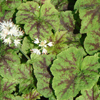
|
Tiarella cordifolia var. collina 'Oakleaf'foamflower
One of the first and still one of the best of the new generation of foamflowers. A very long blooming, clumping plant with wonderfully shaped leaves, light pink flowers and bronze new spring growth. Brilliant burgundy winter color. A shared introduction from the University of Delaware, the Brandywine Conservancy, and Dunvegan Nursery. [
More Info
]
|
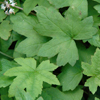
|
Tradescantia ohiensisspiderwort
This spiderwort of Pennsylvania provenance is a great landscape plant for hot sunny locations, unlike others in the genus. Attractive bluish-grey foliage with flowers in blue, pink or purple from early June to September. Think of a flowering grass-like, drought-loving native perennial. [
More Info
]
|
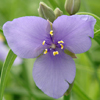
|
Verbena 'Homestead Purple'verbena
Named by Dr. Alan Armitage, of the University of Georgia. Vigorously spreading, deep purple clusters from June to November. Excellent clean, deep green foliage with a trailing habit. Has been surviving the winter here lately, but it gets a very slow start in the spring. Best treated as an annual zone 6 or less. [
More Info
]
|
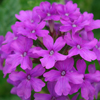
|
Verbena hastataswamp verbena
The tall, thin spikes of Blue Vervain grace the wet meadows of the US in July and August. Verbena hastata is a short-lived perennial that readily self sows where happy. A great plant for pond's edge where it seeds in between sedges and rushes and cheerfully holds its own. [
More Info
]
|
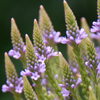
|
Vernonia lettermannii 'Iron Butterfly'ironweed
This selection of the Arkansas native comes to us from Dr. Allan Armitage's trials at the University of Georgia. It has lovely fine foliage like Amsonia hubrichtii and is a compact, well-branched and vigorous plant. In late summer it is covered with true purple flowers that attract plenty of butterflies. Found in rocky flood plains, Vernonia lettermannii is very tolerant of hot, dry locations, yet can withstand brief periods of inundation. [
More Info
]
|
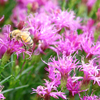
|
Vernonia noveboracensisNew York ironweed
Deep purple haze in damp meadows, roadsides and pastures. A lovely native that adapts well to any moist location.
[
More Info
]
|
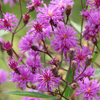
|
Veronicastrum virginicumCulver's root
Big dramatic spikes of white Veronica-like flowers in July and August. Very tough and long-lasting once established. Found in open woods, moist meadows, and praries east of the Rockies. [
More Info
]
|
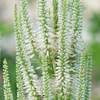
|
Viola walteri 'Silver Gem'prostrate blue violet
From the gardens of Mt. Cuba Center, North Creek is delighted to introduce this tough native groundcover. Easily identified by trailing stems and delicate lavender flowers, 'Silver Gem' forms a dense, tidy mat of attractive silver foliage. Flowers appear in March and persist into autumn. Our plant trials have proven 'Silver Gem' to be exceptionally drought tolerant and happiest in part to full shade. Pot in quarts or gallons for early spring sales. [
More Info
]
|
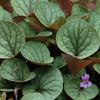
|
Zizia aureagolden Alexanders
Golden clusters of 3-4" umbels in May and June. Deep green, leathery, handsomely divided basal foliage. Native to wooded bottomlands, stream banks, moist meadows, and floodplains east of the Rockies. Very attractive to butterflies. [
More Info
]
|
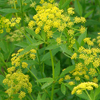
|

